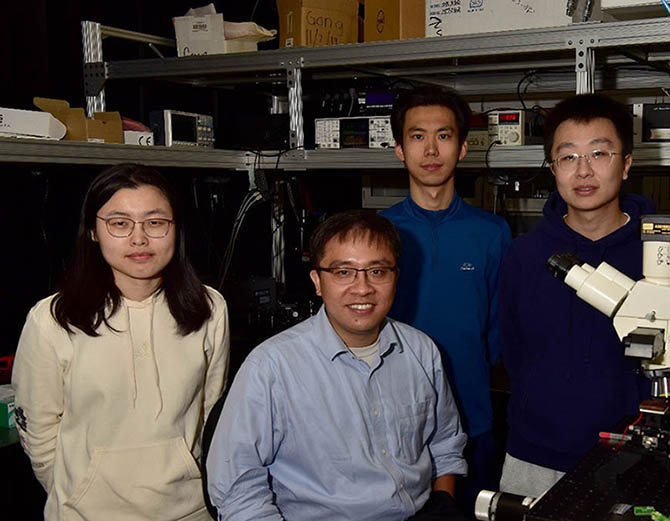News Story
“Unusually high performance of low-dimensional memories”

Photo in Gong lab. From left to right: Dr. Qinqin Wang, Prof. Cheng Gong, Zhihao Song, and Ti Xie.
A paper led by Professor Cheng Gong has been published in the December issue of the Journal Matter. Titled “Extraordinary tunnel electroresistance in layer-by-layer engineered van der Waals ferroelectric tunnel junctions”, this paper shows a 50,000,000,000 ON/OFF ratio in van der Waals ferroelectric tunnel junctions, surprisingly at room temperature. This is a record-high value, at least 10,000X higher than the best conventional memories.
The mainstream information technologies rely on data storage and logic computation, that is, based on the storage and processing of the binary data: 0 or 1. In the fundamental device level, for example a transistor or a memory, computers need to recognize two different resistance states as “0” and “1”, representing the so-called ON or OFF states usually corresponding to the low and high electrical resistances. “There are many schemes for achieving the two contrasting electrical resistances,” said Prof. Gong, the corresponding author of this study, “quantum tunneling, either through magnetic tunnel junction or ferroelectric tunnel junction, represents a powerful route to realizing high ON/OFF ratio, because tunneling is an exponential function of the dimensions of the tunneling media.”
“This demonstration of a record-high ON/OFF ratio in a novel device is really exciting, which showed the promise of two-dimensional material interfaces and their unique attributes that can be exploited.” explains Dr. Jiwei Lu, the program officer of Air Force of Scientific Research (AFOSR). He adds “the main enabling physics for this discovery is rooted in a fact that these two-dimensional materials based tunnel junctions, in principle, are free from the deleterious effects from disorders such as point defects or interfacial states, presenting an electronically very clean tunneling barrier that makes possible the ensuing phenomena discovered by the Gong group”.
“This breakthrough is supported by three pieces of fundamental physics,” Gong further explained, “first, the layered van der Waals materials are defect-free, exhibiting a clean electronic band gap as the clean tunneling barrier; second, the interface between these layers are free from complicated chemical bonding and thus free from the so-called Fermi level pinning; third, the pair of asymmetric electrodes for the ferroelectric tunnel junction are very distinct, with one traditional three-dimensional metal and one two-dimensional carbon sheet. These wonderful features allow the gigantic ferroelectric modulation of the band alignment across the tunnel junction, giving rise to the record-high 50,000,000,000 ON/OFF ratio, even at room temperature in the air”.
Don Woodbury, Director of Innovation and Partnerships, Clark School of Engineering at University of Maryland, says “The van der Waals ferroelectric materials research that has been pioneered in Prof. Gong’s laboratory has significant potential to lead to the development of integrated electromagnetic sensors that have many potentially promising applications in both defense and civilian domains.”
“The uniquely designed devices from the Gong Lab are an impressive advancement due to their ability to sense electromagnetic fields and their anomalies,” says Fredrik Fatemi, UMD Quantum Technology Center (QTC) Associate Director and Army Senior Research Scientist for Quantum Sciences. “These devices could have broad application as field sensors and high-contrast switches with small form factor in an ambient temperature environment.”
“We not merely demonstrated a record-high performance in novel non-volatile memories,” Gong continued to remark, “but also showed the possibility of finely designing the device and its performance in a layer-by-layer fashion, by manually adding one layer and another layer into the device architecture according to the “home-made” recipe. This is a unique platform for many forthcoming physics experiments and unusual discoveries”.
This work was supported by Air Force Office of Scientific Research under the award number FA9550-22-1-0349, Naval Air Warfare Center Aircraft Division under the award number N00421-22-1-0001, and Army Research Laboratory under the cooperative agreement number W911NF-19-2-0181.
Matter is a sister journal to Cell. Published monthly, it focuses on the field of materials science. Its goal is to be an all-encompassing resource for materials science researchers in both academia and industry.
The full paper can be read on the Matter website.
Published December 19, 2022









